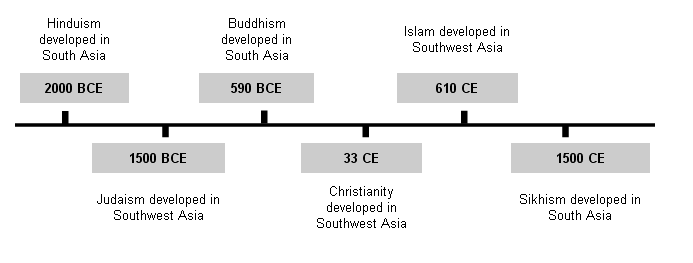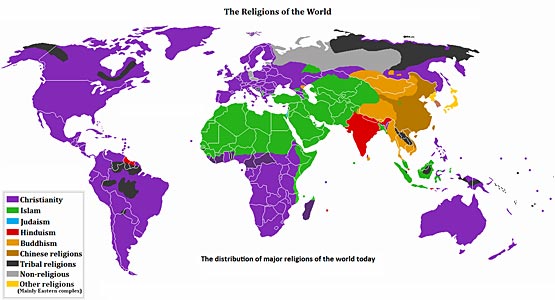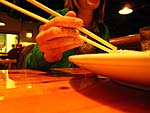
Unit 1: Redefining World Society and Culture
Lesson B: Division and Diffusion — World Belief Systems
Activity 6: Comparing Timelines and Maps
You worked with a variety of charts and maps. Examine the following two visuals again and see how comparing them can help us form historical questions.

Development of World Religions [1]

Distribution of World Religions [2]
From the timeline, you can see where certain religions and belief systems developed. Now, examine the map. This map indicates which religion or belief system a majority of the population practices today.
Look at South Asia. From the timeline, we have learned that three different religions developed in South Asia – Hinduism, Buddhism, and Sikhism. However, when we look at the map, we notice that the dominant religions in South Asia are Hinduism in India (red) and Islam in Pakistan and Bangladesh (green).
Comparing the historical data in these visuals might lead a historian to ask questions such as, "How and why did Pakistan and Bangladesh adopt Islam?" Upon further examination of the two visuals, a historian might notice that Buddhism, which developed in South Asia, is the dominant religion in Japan and parts of China. This might lead a historian to ask how and why Buddhism spread to East Asia.
Written Activity - Notebook
In your notebook, respond to the following question:
- What are three other specific questions a historian might ask after comparing the data on the timeline and the map?

Chopsticks [3]
Most of the historical questions you created probably had to do with cultural diffusion. Cultural diffusion deals with the fundamental question of how the culture of one group of people ended up somewhere else.

Pizza [4]
In the United States, so many cultures make up the American "culture" that some people might not even notice. Think about food. Pizza, tacos, and Chinese food are considered just as "American" as hotdogs and hamburgers. Another area is music. So many of the musical instruments that are used to create "American music" originated in Spain and different parts of Africa (guitars and drums). The architecture of Washington DC is based on buildings built in Greece and Rome, and the majority of people in the United States speak English – from England! So much of what Americans assume is "American" is actually borrowed from somewhere else. All of these are examples of cultural diffusion.

Tacos [5]
Historians look at cultural diffusion to help trace the interactions among different people. One example is languages. Historians can look at different words to conclude that somewhere in history different people had contact with each other. For example, English is actually a Germanic language, but there are many English words that are similar to Spanish words. Historians would ask questions to try to determine how and why similarities like this exist.
How religions traveled from one place to another is an example of cultural diffusion. How and why did certain religions move from one culture to a different one? Why would some people reject one religion to accept a new one? These are great historical questions.
Page Notes:
[1] Source: This image has been created using http://www.teach-nology.com/web_tools/materials/timeline/ with information from http://www.sacred-texts.com/time/origtime.htm.
[2] Source: This image from http://commons.wikimedia.org/wiki/File:Religion_distribution.png is in the public domain.
[3] Source: http://commons.wikimedia.org/wiki/File:Chopsticks_by_evantroborg3000_in_Chicago_Chinatown.jpg is licensed with Creative Commons Attribution. Attribution: evantroborg3000.
[4] Source: This image from http://en.wikipedia.org/wiki/File:Pepperoni_pizza.jpg is in the public domain.
[5] Source: This image from http://commons.wikimedia.org/wiki/File:NCI_Visuals_Food_Taco.jpg is in the public domain.

